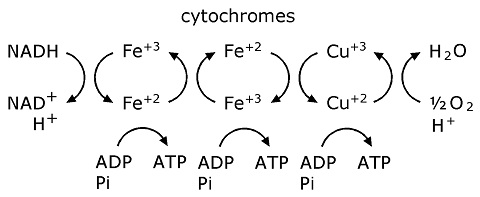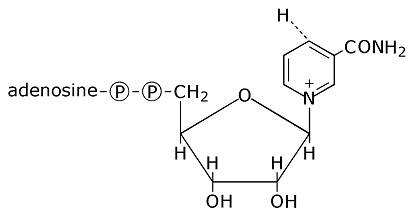|
Respiration
Respiratory Chain System:
The hydrogen attaches to NAD where the dotted line is. Then the plus charge disapears. Cytochromes: Cytochromes are complex structures with iron, copper or other metals in the center for transferring electrons while redistributing the energy. The metals are surrounded by porphyrin rings made of nitrogen and carbon compounds which exchange electrons with the metals. The rings are held in place by proteins. As the metals pick up an electron, they become more negatively charged and are said to be reduced (often +2). As they give up electrons, they become more positively charged and are said to be oxidized (often +3). After the electrons give up a significant amount of their energy, they combine with oxygen and hydrogen to form water. Mitochondria: This process (called oxidative phosphorylation) usually occurs in mitochondria. However, abbreviated forms of it occur in bacteria which do not have mitochondria. Mitochondria are somewhat like cells within cells. They are surrounded by a double layered membrane. Hydrogen ions (protons) are pumped between those membranes creating an osmotic pressure gradient. The osmotic pressure moves the hydrogen from one point to another, so it can relocate from NADH to oxygen. The hydrogen moves back into the mitochondria by passing through a protein complex which it sets in motion creating a turning wheel. The wheel picks up ADP and Pi and brings them together to reconstruct ATP. Also within the mitochondria is breakdown metabolism which yields most of the energy. It breaks down two-carbon compounds which usually originate with glucose. The resulting metabolism yields NADH which carries the energy to the respiratory chain system.
|

